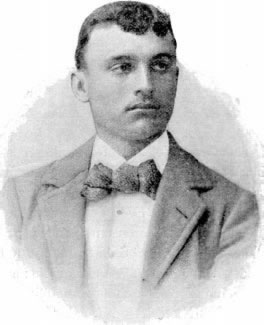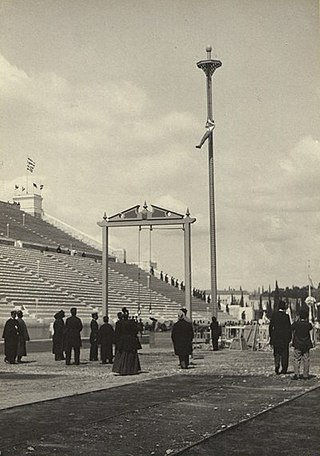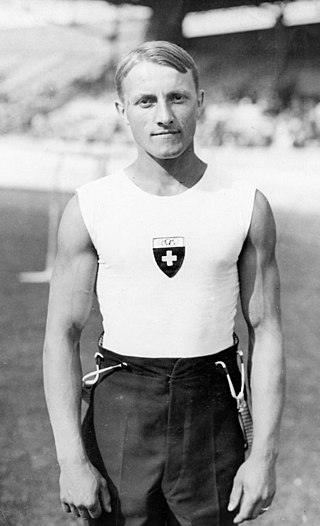
The 1904 Summer Olympics were an international multi-sport event held in St. Louis, Missouri, United States, from 1 July to 23 November 1904. Many events were conducted at what is now known as Francis Field on the campus of Washington University in St. Louis. This was the first time that the Olympic Games were held outside Europe.

At the 1900 Summer Olympics one gymnastics event for men was contested. The competition was held on Sunday, 29 July 1900, and on Monday, 30 July 1900. There were 135 competitors from 8 nations. The top 18 places were taken by French gymnasts, of which there were more than 100. The event was won by Gustave Sandras, with Noël Bas finishing second and Lucien Démanet third. The highest-placing foreign gymnast was Jules Ducret of Switzerland, in a tie for 19th place.
Fritz Hofmann was a German athlete. He competed at the 1896 Summer Olympics in Athens.

Nikolaos Andriakopoulos was a Greek gymnast. He was a member of Panachaikos Gymnastikos Syllogos, that merged in 1923 with Gymnastiki Etaireia Patron to become Panachaiki Gymnastiki Enosi.

Gymnastics events have been contested at every Summer Olympic Games since the birth of the modern Olympic movement at the 1896 Summer Olympics in Athens. For 32 years, only men were allowed to compete. Beginning at the 1928 Summer Olympics in Amsterdam, women were allowed to compete in artistic gymnastics events as well. Rhythmic gymnastics events were introduced at the 1984 Summer Olympics in Los Angeles, and trampoline events were added at the 2000 Summer Olympics in Sydney.

The men's rope climbing was one of eight gymnastics events on the Gymnastics at the 1896 Summer Olympics programme. The final event in the gymnastics competition, rope climbing was held on 10 April. The rope was 14 metres long, suspended from a frame. Time and style were considered in placing the competitors who reached the top and distance climbed separating those who did not make it all the way up. Five competitors entered, with the two Greeks taking top honors by being the only two to complete the climb. The German Fritz Hofmann won the bronze medal, while the weightlifting champions Viggo Jensen and Launceston Elliot finished fourth and fifth.

The men's individual all-around, also known as the heptathlon, was one of two gymnastics events on the Gymnastics at the 1908 Summer Olympics programme. As suggested by the alternate name, the competition included seven events with the scores summed to give a final score. Each nation could enter up to 20 gymnasts, with France and Great Britain each entering the maximum. A total of 97 gymnasts from 12 nations competed. The event was won by Alberto Braglia of Italy, the nation's first medal in the men's individual all-around. Silver went to Walter Tysall of Great Britain, the first medal for the nation as well. France's Louis Ségura earned bronze.

George Louis Eyser was a German-American gymnast who competed in the 1904 Summer Olympics, earning six medals in one day, including three gold and two silver medals. Eyser competed with a wooden prosthesis for a left leg, having lost his leg after being run over by a train. Despite his disability, he won gold in the vault, an event which then included a jump over a long horse without aid of a springboard.

The men's rope climbing was an artistic gymnastics event held as part of the gymnastics programme at the 1904 Summer Olympics. It was the second time the event was held at the Olympics. An unknown number of gymnasts competed; only three are known, all American. The competition was held on Friday, October 28, 1904. George Eyser won the event, with Charles Krause second and Emil Voigt third.
Julius Lenhart was an Austrian gymnast who competed in the 1904 Summer Olympics. He won two gold medals and one silver medal, making him the most successful Austrian competitor ever at the Summer Olympic Games.
Max Hess was an American gymnast and track and field athlete who competed in the 1904 Summer Olympics in St. Louis. He was born in Coburg, Germany, and came to America at an early age, settling in Philadelphia.
Emil Voigt was an American gymnast who competed in the 1904 Summer Olympics.

Albert Séguin was a French gymnast and Olympic champion. He competed at the 1924 Summer Olympics, where he received a gold medal in sidehorse vault, and silver medals in rope climbing and in team combined exercises.

August Güttinger was a Swiss gymnast and Olympic Champion. He competed at the 1924 Summer Olympics, where he received a gold medal in parallel bars, and bronze medals in rope climbing and team combined exercises. He received a gold medal in team combined exercises at the 1928 Summer Olympics in Amsterdam.
Raymond Henry "Benny" Bass was a gymnast who represented the United States. As a member of the United States men's national artistic gymnastics team, he was an Olympic gold medalist in the 1932 Summer Olympics.
William Jackson "Jack" Galbraith was a gymnast and Olympic medalist in the 1932 Summer Olympics. He was a member of the United States men's national artistic gymnastics team and competed at the 1932 Summer Olympics in Los Angeles where he won a silver medal in rope climbing. He served as a Rear Admiral in the United States Navy from 1929 through 1959 and was awarded a Silver Star, Bronze Star Medal, Purple Heart, and Presidential Unit Citation.

Ladislav Vácha was a Czech gymnast and Olympic champion competing for Czechoslovakia.

The men's artistic individual all-around event was part of the gymnastics programme at the 1924 Summer Olympics. It was one of nine gymnastics events and it was contested for the sixth time. The competition was held from Thursday, 17 July 1924, to Wednesday, 23 July 1924. Seventy-two gymnasts from nine nations competed. Each nation could send up to 8 gymnasts, up from 6 in previous Games. For the first time since 1904, the scores for individual competitors were used to calculate a team score. The men's artistic individual all-around was won by Leon Štukelj of Yugoslavia. Czechoslovakia's Robert Pražák took silver, while Bedřich Šupčík earned bronze. Both nations were making their debut in the event.

The men's rope climbing event was part of the gymnastics programme at the 1932 Summer Olympics. It was contested for the fourth and last time after 1896, 1904, and 1924. The competition was held on Wednesday, August 10, 1932. Five gymnasts from two nations competed. All three medalists were from the host nation, as Americans Raymond Bass, William Galbraith, and Thomas F. Connolly took the honors.

The men's artistic individual all-around event was part of the gymnastics programme at the 1928 Summer Olympics. It was one of seven gymnastics events for men and was the seventh Olympic men's all-around gymnastic championship. Scores from the individual apparatus events were added to give aggregate scores for the individual all-around; individual all-around scores were similarly summed for the team all-around event. There were 88 competitors from 11 nations. Each nation sent a team of 8 gymnasts. The event was won by Georges Miez of Switzerland, with his countryman Hermann Hänggi taking silver. They were the first medals in the event for Swiss gymnasts since 1904 and the first gold medal ever for a Swiss man in the individual all-around. Defending Olympic champion Leon Štukelj of Yugoslavia finished with the bronze this time, making him the third man to win multiple medals in the event.










